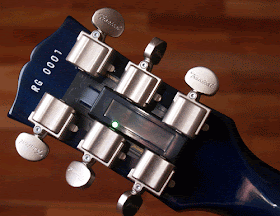Today we will talk about a topic that is often overlooked:
Guitar and bass tuners!
A tuner is a device that takes the sound of our strings and determines the pitch, and then tells us what note it is, or how to adjust the tuning until we reach exactly the note we need.
Unless we have an absolute ear that lets us determine with perfect precision what note is our string and how to correct it, we absolutely need a tuner.
There are different types of tuner, but they all do the same job: help us in finding the right pitch for our strings. Let's check them out:
- Compact tuners: these are the most common, and can be both digital (like this one depicted above), or analog (like the one in the picture on top). They can usually receive the sound via jack input, or with an in-built microphone (this one is used to tune acoustic instruments).
- Clip Tuners: these gets attached to the guitar headstock with a clip, and they determine the pitch of the string played using the vibrations on the wood. This is the most compact and lightweight tuner of all, but sometimes it is a bit less accurate than the others, imho.
- Acoustic guitar in built tuner: many recent acoustic guitars feature a small tuner built within the body itself of the guitar, and it is usually paired with a pickup that lets us plug the acoustic guitar into an amp with a jack.
- Stompbox tuner: one of the most classic tuners of all, this one lets us mute the guitar while tuning on stage and it's particularly bright to be seen also in dim light conditions. The best ones are "true bypass", which means that doesn't deteriorate the guitar signal passing through them.
- Vst tuners: today many daw offer a vst tuner, in order to tune our instruments plugged into the audio interface. You can download for example GVST GTune, a good free vst tuner (with also the Hertz calibration, so that if you don't want to tune with the A at 440hz you can modify it, for example at 432hz).
These are the most used technologies so far.
Lately there have been attempt of simplifying the tuning system, but not always they turned out to be succesful:
Gibson experimented the Les Paul Robot, a guitar that can tune iself due to motorized locking tuners, but it didn't have much success due to its extremely high price and the fact that the technology was very fragile, and Peavey presented the Peavey AT serie, that uses a form of Autotune in order to digitally correct the tuning of the strings.
The downside of this technology is the fact that the strings actually remains out of tune, only the output pitch is digitally corrected, therefore the result is that after a while the string will have, even if it sounds in tune, a weird tension.Our hope is, looking at it by a real utility point of view, that someday every amp will have a small in built tuner, because that would be really useful and make the guitar and bass player's life easier.
Become fan of this blog on Facebook! Share it and contact us to collaborate!!








No comments:
Post a Comment